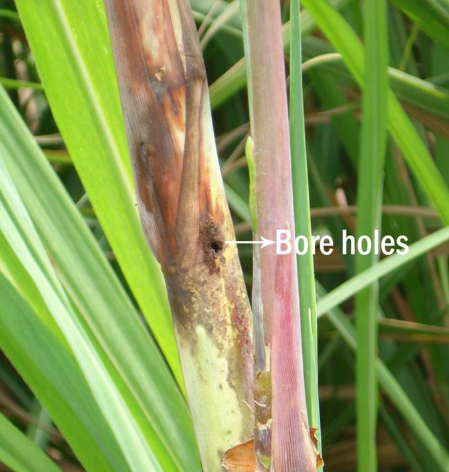Sugarcane Top Shoot borer Management (Control Measure), Pest characters, and Nature of Damage
Scientific name: Scirpophaga excerptalis.
Family: Pyralidae.
Order: Lepidoptera.
Pest characters of Sugarcane Top Shoot borer
i. Adults are milky white in colour.
ii. Insects found in India, Pakistan and Bangladesh.
iii. Larvae are also white in colour.
Nature of Damage of Sugarcane Top Shoot borer
1. It is serious pest of sugarcane.
2. Adult female lays eggs on underside of the leaves in masses which is covered with brown tuft of hair.
3. After hatching the eggs, the young larvae enter into the mid rib of leaf mining there towards the leaf base. From there the larvae enter into the growing point (Spindle) and feed inside.
4. Depending on the age of plant two types of symptoms are developed.
5. When plants are attacked at early stage before cane formation, the central leaf die. The symptom is called “Dead heart”.
6. When the plants are attacked at later stage (after cane formation) a bunch of leaves develops from the top of the plant and the symptom is called “Bunchy top”.
7. If dead heart symptom appears then 100 % loss occur and if bunchy top symptoms occurs then 20 % loss may occur.
Sugarcane Top Shoot borer Management/Control Measure
A. Nonchemical control of Sugarcane Top Shoot borer
1. Collection and destruction of adults and egg masses.
2. Infestation free setts should be used.
3. Destruction of infected plants.
4. Avoiding of ratooning crop.
5. Excess nitrogenous fertilizer should be avoided.
6. Trichogramma chilonis and Isotima javensis parasitoids should be released against 3rd or 4th broods.
B. Chemical control of Sugarcane Top Shoot borer
1. Application of Diazinon/ Diginol 60 EC @ 3 ml/L of water.
2. Application of Curaterr 5G @ 40 kg/ha.
3. Application of Azodrin/ Nuvacron 40 WSC @ 3 ml/L of water.
